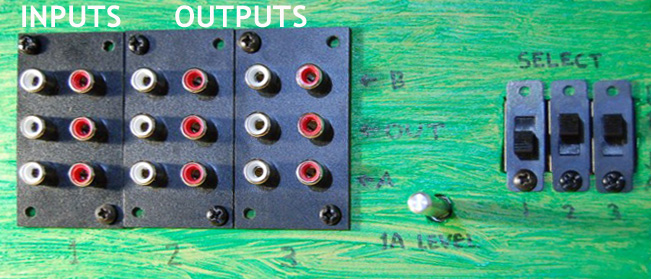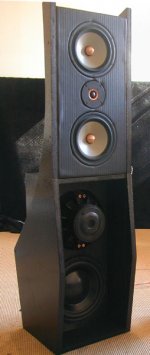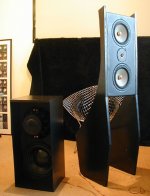Not really . . . John K is quite satisfied with the performance of the mini-DSP line, and on that at least we completely agree . . .....but then you need at leat a 6 channels DAC, a good one is $$$.
An LX521 with MiniDSP sounds like a no brainer indeed.
First, it cost much cheaper (8-channel MiniDSP, 96khz is $300 compared to $700 ASP).
Second, it will get rid of that passive XO in the middle, making it a true active 4-way loudspeakers with all their inherent benefits. Also, the ability to time align the drivers with true delays etc.
Third, it's really easy to reconfigure and reuse for "future projects" as new ideas come along.
First, it cost much cheaper (8-channel MiniDSP, 96khz is $300 compared to $700 ASP).
Second, it will get rid of that passive XO in the middle, making it a true active 4-way loudspeakers with all their inherent benefits. Also, the ability to time align the drivers with true delays etc.
Third, it's really easy to reconfigure and reuse for "future projects" as new ideas come along.
I'm glad to hear others validate this decoupling concept. I did it in my open baffle speakers, but never did any valid comparison tests to see how much it helps.In my own experiments, stopping the speaker carcase vibrating, or damping that excess energy that has to go somewhere when speaker drivers are working hard, pushing back and forth on the baffle, has made a very significant difference, creating a better sense of space.
Frank
http://www.spiritone.com/~rob_369/audio/AuriumWaveguide2010.htm
It made sense to me theoretically, so I did it. I do have spell binding imaging and sense of space with these babies. 😎
That could be argued, but after seeing the analog circuitry on the Behringer DCX2496 (pretty bad)... If they screwed up the analog section that bad, then I have to wonder about the quality of the digital processing. It's over my head to write code for that so I have no idea. Not that they would ever give me access to their code. Test equipment may seem to verify and validate Behringer units with specific setup conditions, but it still leaves me wondering. With analog, I can easily see exactly what is being done to the signal. I know this isn't a Behringer circuit, but again, there's no way for me to know what's being done in any digital processor.An LX521 with MiniDSP sounds like a no brainer indeed.
First, it cost much cheaper (8-channel MiniDSP, 96khz is $300 compared to $700 ASP).
Second, it will get rid of that passive XO in the middle, making it a true active 4-way loudspeakers with all their inherent benefits. Also, the ability to time align the drivers with true delays etc.
Third, it's really easy to reconfigure and reuse for "future projects" as new ideas come along.
Here's what I found on the Behringer unit, and what I did about my DEQ2496 after hearing about it from a very astute engineer (Gary Pimm), and hearing two different Behringer service reps tell me Behringer is not necessarily very good stuff:
http://www.spiritone.com/~rob_369/audio/Behringer%20analog%20mod.htm
miniDSP is not a Behringer product . . .but after seeing the analog circuitry on the Behringer DCX2496 (pretty bad)...
I was a DSP non-believer too. Then we did this ...
Red Spade Audio: Active crossover listening tests
Using quick switch, we even compared it with straight wire!
Red Spade Audio: Active crossover listening tests
Using quick switch, we even compared it with straight wire!
No difference, even when compared to straight-wire.
We used instant-switching between the units. This contraption was custom-made for the endeavor

We used instant-switching between the units. This contraption was custom-made for the endeavor

Last edited:
I have had the miniDsp in mind for a while, some people like it, some don't, given the price I guess it's worth a try..
But I did have a bad experience with the DCX2496 a while ago. I just did not like the sound. The analog section is very poorly made, there is just too much work to be done there.. some people like to tweak these devices, I don't find it funny, so I sold it. It now makes me wary of "cheap" devices, unfortunately. Especially with high end speakers. 😱
The analog crossovers from SL do not sound bad at all, I would definitely qualify them as transparent, with less flexibility obviously..
But I did have a bad experience with the DCX2496 a while ago. I just did not like the sound. The analog section is very poorly made, there is just too much work to be done there.. some people like to tweak these devices, I don't find it funny, so I sold it. It now makes me wary of "cheap" devices, unfortunately. Especially with high end speakers. 😱
The analog crossovers from SL do not sound bad at all, I would definitely qualify them as transparent, with less flexibility obviously..
Duntech built such speakers that were some of the best I had heard at the time. It was a simple two way about three inches thick. I think Dunleavy was on to something. RegardsThanks but what about ON wall? Virtually nobody does it. Why? No benefits? Commercial designs wouldn't fit in a shipping container and DIYers only build things they have seen elsewhere?
You could use them to hang a coat 🙂
True, but they are not (much longer) for this world. They are expensive to build, with an ever dwindling availability of suitable components. A wide range of resistor values is, and will probably remain, reliably available. "Conventional" active filters still designable, but you have to carefully watch capacitor values with an eye to long term supply. Populating a PCB does not inspire many would-be builders, but small production runs don't justify automated board assembly.The analog crossovers from SL do not sound bad at all, I would definitely qualify them as transparent, with less flexibility obviously..
And yes, flexibility. I'm pretty sure LX521 would be 4-way active if the ORION ASP boards supported it . . . the cost of re-tooling drove the hybrid design. And digital just offers so many features/functions that are not practical, or doable at all, with analog designs. Learn to love it . . .
Actual "ON" wall suffers nasty ripple from baffle edge effects. "IN" wall (essentially infinite baffle) resolves that, but requires structural alteration that most people are unwilling to undertake. The theoretical advantage of putting more of the positional and ambience information solely under the control of the recording (or delivery system) must be weighed against the significant absense of such information in most recordings. Many in-wall speaker installations sound (go figure) dimensionally "flat" . . . there is something clearly beneficial about front wall reflections for providing a sense of depth and "spaciousness". Although those reflections clearly don't represent anything in the original performance space they seem to enhance our ability to perceive it from whatever clues are actually in the recording.Thanks but what about ON wall? Virtually nobody does it. Why?)
So, the simple "in general" answer? They're hard to install and don't sound all that good. Multi-channel and more advanced signal processing may resolve the "don't sound good" issues, but the result won't be any more "real" than just accepting, and using, front wall reflections.
I have a major problem with this speaker for the studio applications. I do not see how if you are sitting behind a mixing console you are going to be able to use the speaker as it is designed? I would think that you would have to raise the speaker up off the floor to have any chance of hearing any direct sound from this design. Now if you raise the speaker up let's say a meter or more then all of the sound design will change on this speaker. How would you practically use this design in a studio I just don't understand.
It looks like some rebels are promoting ordinary floor speakers in studio:
An externally hosted image should be here but it was not working when we last tested it.
If you place yourself behind the console sitting it the mixer chair you propably would not see but the top part of the speaker. Massive diffraction occurs at the console edge.
- Elias
Actual "ON" wall suffers nasty ripple from baffle edge effects.
Can be controlled by appropriate driver selection and/or roundovers/absorption. A thermoformed enclosure with minimal diffraction shouldn't be too hard to do.
I believe the recording should control the spatial presentation, not the speaker. Of course you're free to do whatever you want, it's just not what the creator of a recording intended.
By the way, I doubt it's the front wall reflections that create the spaciousness effects you were talking about. It's more likely first reflections from lateral and elevated locations. If that's true, a dipole isn't the best solution.
It looks like some rebels are promoting ordinary floor speakers in studio:
An externally hosted image should be here but it was not working when we last tested it.
If you place yourself behind the console sitting it the mixer chair you propably would not see but the top part of the speaker. Massive diffraction occurs at the console edge.
- Elias
That is not a studio. It is a joke. 🙄
That is not a studio. It is a joke. 🙄
Well what do I know
An externally hosted image should be here but it was not working when we last tested it.
My favorite song of all time was recorded there.
Wait for the crescendo......
Sigur Rós - Ára Bátur (HD) (at Abbey Road Studios) - YouTube
Wait for the crescendo......
Sigur Rós - Ára Bátur (HD) (at Abbey Road Studios) - YouTube
I'm curious why they say the DSP crossovers don't work well with tube preamps (?) That they say that and don't mention why makes me wonder... Perhaps the DSP units can't handle the dynamic range of a typical tube preamp (?)I was a DSP non-believer too. Then we did this ...
Red Spade Audio: Active crossover listening tests
Using quick switch, we even compared it with straight wire!
I'm curious why they say the DSP crossovers don't work well with tube preamps (?) That they say that and don't mention why makes me wonder... Perhaps the DSP units can't handle the dynamic range of a typical tube preamp (?)
To me it seems a waste to run tube gear before an AD/DA conversion. Kinda like running a record player into a PC/DSP box. You lose the "magic" of the analog gear. It has nothing to do with dynamic range.
- Home
- Loudspeakers
- Multi-Way
- New Linkwitz "LX521" speakers..

